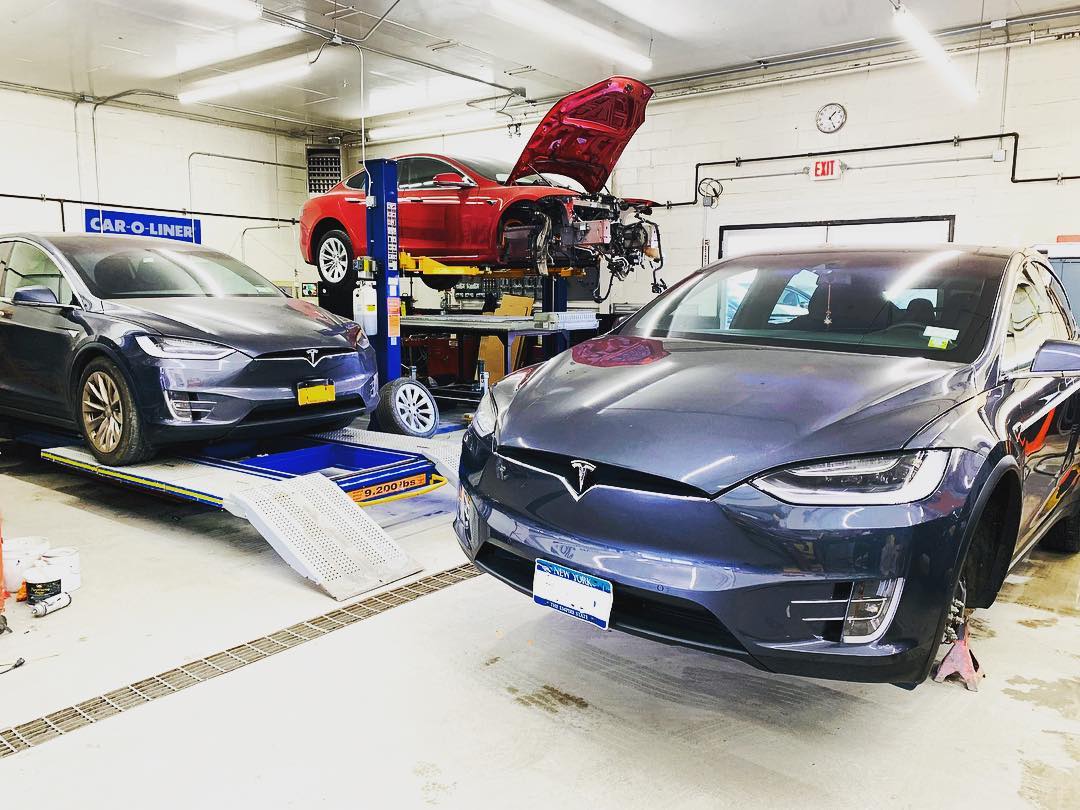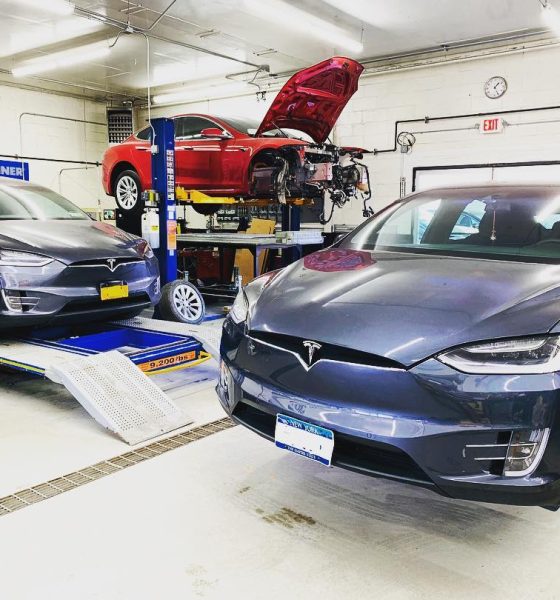

News
Tesla acknowledges its service challenges, pledges serious repair team ramp
It’s no secret that Tesla is experiencing challenges meeting the service needs of its customers, with some owners noting that appointments with the company’s service team are now available weeks or even months out. This has caused an issue of sorts for Tesla. Its vehicles may indeed provide the best ownership experience in the market — as long as they don’t require service. Once they do, then a substantial amount of patience is advised on the owners’ part.
The issue of Tesla’s service network and its present shortcomings was discussed by CFO Zachary Kirkhorn during the Q3 2021 earnings call. According to the executive, there are a couple of factors that contributed to the current service situation, from the pandemic and the world’s recovery from it, as well as the ongoing supply chain challenges. Kirkhorn noted, however, that some of Tesla’s service issues are not necessarily exclusive to the company.
“There’s a couple of things that have contributed to that based upon the information that we have. The first is that — and I think this is kind of not — this is not unique to us, is that the return to some sense of normalcy in a post-pandemic world has happened, I think, more quickly than most people expected. And what we’re seeing here is that the number of miles that people are driving has increased. There may have been some demand for service during 2020 or in the early parts of 2021 that customers put off, and so there’s a bit of a catch-up that’s occurring.
“That has increased demand for service. At the same time, in the macro-environment here, logistics, moving parts, sourcing parts has become increasingly more difficult, which is a well-known issue in the world right now, as well as challenges in the labor market. And so this kind of the simultaneous increase in demand for service with the ability to supply that service has been impacted for the reasons I mentioned. And so we saw an uptick primarily in Europe and North America in service wait times over the course of the summer,” Kirkhorn noted.
The Tesla CFO added that the company is doing what it can to grow its service network, from its physical centers to its mobile service fleet. Kirkhorn noted that over the last year, and despite the presence of the pandemic, Tesla’s physical service centers grew by 35%, and the mobile service fleet saw an even more impressive growth of 40%. But amidst these efforts, the CFO reiterated that Tesla’s primary goal is still to create vehicles that are extremely reliable, since the best service is no service.
“And we’ve been working extremely hard since then to address this, and we’ve seen our wait times come down. So this is not the case in every location, but if you think about it from regional average perspective, we are seeing improvements there. We remain super-focused on adding locations. And so over the last year, we’ve grown our physical footprint of service centers by 35%.
“We’ve grown our footprint of mobile repair by over 40%. We’re also adding staffing as quickly as we can in the areas that are most impacted by the imbalance of supply and demand for service. But I think the most important part about all of this is — and we’ve said this on calls before, where the best service is no service. And so we have been incredibly focused as a company both on the initial quality of our vehicles and reliability of our vehicles,” Kirkhorn said.
Don’t hesitate to contact us with news tips. Just send a message to tips@teslarati.com to give us a heads up.

Elon Musk
SpaceX issues statement on Starship V3 Booster 18 anomaly
The incident unfolded during gas-system pressure testing at the company’s Massey facility in Starbase, Texas.

SpaceX has issued an initial statement about Starship Booster 18’s anomaly early Friday. The incident unfolded during gas-system pressure testing at the company’s Massey facility in Starbase, Texas.
SpaceX’s initial comment
As per SpaceX in a post on its official account on social media platform X, Booster 18 was undergoing gas system pressure tests when the anomaly happened. Despite the nature of the incident, the company emphasized that no propellant was loaded, no engines were installed, and personnel were kept at a safe distance from the booster, resulting in zero injuries.
“Booster 18 suffered an anomaly during gas system pressure testing that we were conducting in advance of structural proof testing. No propellant was on the vehicle, and engines were not yet installed. The teams need time to investigate before we are confident of the cause. No one was injured as we maintain a safe distance for personnel during this type of testing. The site remains clear and we are working plans to safely reenter the site,” SpaceX wrote in its post on X.
Incident and aftermath
Livestream footage from LabPadre showed Booster 18’s lower half crumpling around the liquid oxygen tank area at approximately 4:04 a.m. CT. Subsequent images posted by on-site observers revealed extensive deformation across the booster’s lower structure. Needless to say, spaceflight observers have noted that Booster 18 would likely be a complete loss due to its anomaly.
Booster 18 had rolled out only a day earlier and was one of the first vehicles in the Starship V3 program. The V3 series incorporates structural reinforcements and reliability upgrades intended to prepare Starship for rapid-reuse testing and eventual tower-catch operations. Elon Musk has been optimistic about Starship V3, previously noting on X that the spacecraft might be able to complete initial missions to Mars.
Investor's Corner
Tesla analyst maintains $500 PT, says FSD drives better than humans now
The team also met with Tesla leaders for more than an hour to discuss autonomy, chip development, and upcoming deployment plans.

Tesla (NASDAQ:TSLA) received fresh support from Piper Sandler this week after analysts toured the Fremont Factory and tested the company’s latest Full Self-Driving software. The firm reaffirmed its $500 price target, stating that FSD V14 delivered a notably smooth robotaxi demonstration and may already perform at levels comparable to, if not better than, average human drivers.
The team also met with Tesla leaders for more than an hour to discuss autonomy, chip development, and upcoming deployment plans.
Analysts highlight autonomy progress
During more than 75 minutes of focused discussions, analysts reportedly focused on FSD v14’s updates. Piper Sandler’s team pointed to meaningful strides in perception, object handling, and overall ride smoothness during the robotaxi demo.
The visit also included discussions on updates to Tesla’s in-house chip initiatives, its Optimus program, and the growth of the company’s battery storage business. Analysts noted that Tesla continues refining cost structures and capital expenditure expectations, which are key elements in future margin recovery, as noted in a Yahoo Finance report.
Analyst Alexander Potter noted that “we think FSD is a truly impressive product that is (probably) already better at driving than the average American.” This conclusion was strengthened by what he described as a “flawless robotaxi ride to the hotel.”
Street targets diverge on TSLA
While Piper Sandler stands by its $500 target, it is not the highest estimate on the Street. Wedbush, for one, has a $600 per share price target for TSLA stock.
Other institutions have also weighed in on TSLA stock as of late. HSBC reiterated a Reduce rating with a $131 target, citing a gap between earnings fundamentals and the company’s market value. By contrast, TD Cowen maintained a Buy rating and a $509 target, pointing to strong autonomous driving demonstrations in Austin and the pace of software-driven improvements.
Stifel analysts also lifted their price target for Tesla to $508 per share over the company’s ongoing robotaxi and FSD programs.
Elon Musk
SpaceX Starship Version 3 booster crumples in early testing
Photos of the incident’s aftermath suggest that Booster 18 will likely be retired.

SpaceX’s new Starship first-stage booster, Booster 18, suffered major damage early Friday during its first round of testing in Starbase, Texas, just one day after rolling out of the factory.
Based on videos of the incident, the lower section of the rocket booster appeared to crumple during a pressurization test. Photos of the incident’s aftermath suggest that Booster 18 will likely be retired.
Booster test failure
SpaceX began structural and propellant-system verification tests on Booster 18 Thursday night at the Massey’s Test Site, only a few miles from Starbase’s production facilities, as noted in an Ars Technica report. At 4:04 a.m. CT on Friday, a livestream from LabPadre Space captured the booster’s lower half experiencing a sudden destructive event around its liquid oxygen tank section. Post-incident images, shared on X by @StarshipGazer, showed notable deformation in the booster’s lower structure.
Neither SpaceX nor Elon Musk had commented as of Friday morning, but the vehicle’s condition suggests it is likely a complete loss. This is quite unfortunate, as Booster 18 is already part of the Starship V3 program, which includes design fixes and upgrades intended to improve reliability. While SpaceX maintains a rather rapid Starship production line in Starbase, Booster 18 was generally expected to validate the improvements implemented in the V3 program.
Tight deadlines
SpaceX needs Starship boosters and upper stages to begin demonstrating rapid reuse, tower catches, and early operational Starlink missions over the next two years. More critically, NASA’s Artemis program depends on an on-orbit refueling test in the second half of 2026, a requirement for the vehicle’s expected crewed lunar landing around 2028.
While SpaceX is known for diagnosing failures quickly and returning to testing at unmatched speed, losing the newest-generation booster at the very start of its campaign highlights the immense challenge involved in scaling Starship into a reliable, high-cadence launch system. SpaceX, however, is known for getting things done quickly, so it would not be a surprise if the company manages to figure out what happened to Booster 18 in the near future.








